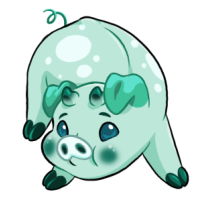 Marshog Vocalis oinkus
Marshog Vocalis oinkus
Pets

APPEARANCE
Sizewise, most marshogs range from the size of a cat to the height of an average adult Dextroluma. Green arboreal marshogs are the most abundant type, however, marshogs come in a number of different appearances, some of which seem to be influenced by seasons or even by strange magics. To see the currently available different types of marshog, please visit the Encyclopedia.
HABITAT
Most wild marshogs live in the thickets of the Swamplands. They live off abundant vegetation and thrive with few predators - most predation of marshogs occurs when they leave the thickets to seek water sources.
Behaviors
Marshogs are known to make noises similar to the pigs of Earth - squeaking, oinking, and even bellowing. They are capable of learning tricks and to understand basic speech and simple concepts from their owners. That capability, however, does not mean they always wish to learn. An awful lot of marshogs would rather snooze and eat all day than perform for an owner's amusement - but of course, there are plenty who find doing tricks and learning new things to be fun and enjoyable. Marshogs have an instinctive desire to have a safe place to hide in - in the wild, that is thickets or even caves. In a typical home, it is best to provide them with something along the lines of a doghouse to conceal themselves in, and a lot of pillows and blankets to make a comfortable nest.
DIET
Wild marshogs eat literally anything they can find. For the most part, that means vegetation - underbrush, hanging vines, leaves, tree bark, berries, mushrooms, roots... Occasionally, it means the remains of kills by predator animals, eggs from other species' nests, or even would-be predators and hunters. Domesticated marshogs typically are strictly fed plants and mushrooms, but it is not unheard of for a marshog to steal meat off their owner's plate if given the chance. They are opportunists above all else.
ROLES
Wild marshogs tend to be omnivorous opportunists. While they are seen as prey more often than not, it is hardly unheard of for them to act as predators.
REPRODUCTION
Eggs.
LIFESPAN
Due to the effects of magic, marshogs owned by another species will live for as long as their owner does. A wild or feral marshog will typically live between two to ten years.
CORRUPTION
Marshogs can contract necrosis, however, it has been noted that corrupted ones seem to change from their original variety into something unique to their kind, as do cured ones. It is unknown why this is, but it is hypothesized to be an evolutionary adaptation to allow them to survive on a new mushroom diet, as corrupted and cured marshogs seem to need different mushrooms from their pure counterparts.

